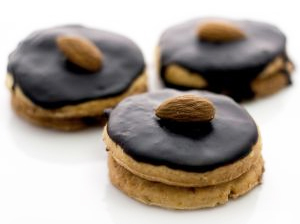 EAT A COOKIE
EAT A COOKIE
already
The Featured Artist Contest means different things to different people. Some artists feel that it is validation and merely appreciate the recognition of their work. Some artists spin it into great publicity for what they do and to funnel people to their website. This contest remains a way to help artists get outside their heads and take a look at how their inspirations and influences have really changed their work over the years. During the interview of this month’s artist, I believe her answers may have even surprised her. It’s nice to know we can still do that here at AAAD.
This month’s artist works in a media with which I am not familiar. Her work is both industrial and organic. It has the duality of being both stark AND somehow soft and comforting. On behalf of ArtAndArtDeadlines.com, I am proud to announce the Featured Artist chosen from the November entries to the $5 Art Contest is Julie Alland. Her artwork seems to freeze a moment in time. And, while Alland has a hand in the composition and an expectation of the outcome, she isn’t in complete control of the work. It’s a little like life, don’t you think? With the new year approaching, I encourage each of you to have a hand in the composition of your life and art, but don’t keep to tight a grip on the end result. Let Julie be your inspiration…
FEATURED ARTIST:
Julie Alland
Julie Alland is a sculptor who lives and works in San Francisco. Raised in New York State, Alland earned a BFA from Antioch University in Ohio, specializing in photography. After moving to San Francisco in 1985 Alland became fascinated with found objects, and although she’d had little formal training in sculpture, her interest turned to working in three dimensions. Casting became a fundamental part of Julie’s work in 1993 after teaching herself mold making and casting in order to bring an idea to realization. In 2002, Julie enrolled in a kiln casting class taught by C. Matthew Szosz at Public Glass in San Francisco. The class was her first experience casting glass.
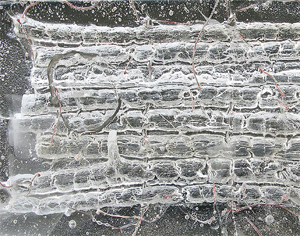 The unique physical properties and technically challenging nature of casting glass motivated Alland to take her work in a new direction. She continued to hone her glass casting skills during several summer sessions at the Pilchuck Glass School. Julie’s first class at Pilchuck: Survey of Glass Techniques, taught by Karen Lamonte in 2003, introduced her to sand casting. Interest in developing a distinctive visual vocabulary led Alland to focus on experimenting with the technique in subsequent years. This exploration resulted in the method she uses to produce her sand cast work today.
The unique physical properties and technically challenging nature of casting glass motivated Alland to take her work in a new direction. She continued to hone her glass casting skills during several summer sessions at the Pilchuck Glass School. Julie’s first class at Pilchuck: Survey of Glass Techniques, taught by Karen Lamonte in 2003, introduced her to sand casting. Interest in developing a distinctive visual vocabulary led Alland to focus on experimenting with the technique in subsequent years. This exploration resulted in the method she uses to produce her sand cast work today.
Clearly, your work took a sharp left turn from your education in photography. Tell me how (and if) photography still influences your work. “My first impulse is to say that photography hasn’t influenced my work one bit. Now that I think about it, (thanks for bringing it up) maybe it has after all. Much of the imagery in my work suggests forms of life — usually only seen via photographs taken in the deep sea or through a microscope. Another trait my work shares with photography is the importance I place on composition.” I suspect my love of photography is what initially drew me to your work, Julie.
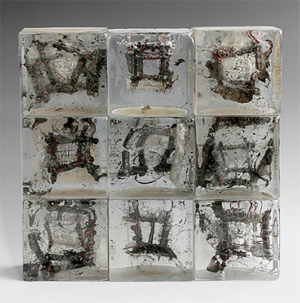 Talk to me about the process you use. How much control do you really have over the finish product? “My technique consists of creating abstract images by bending wire and wrapping it around sticks (inclusions). A mold is made by pushing a three dimensional shape into a sand mixture. The wire and sticks are placed in the mold, then molten glass is poured over them. The hot glass burns out the organic elements and a void in the shape of the wood remains in its place. Gasses escape from the metal and wood, bubbles and sometimes ash rise up into the glass.
Talk to me about the process you use. How much control do you really have over the finish product? “My technique consists of creating abstract images by bending wire and wrapping it around sticks (inclusions). A mold is made by pushing a three dimensional shape into a sand mixture. The wire and sticks are placed in the mold, then molten glass is poured over them. The hot glass burns out the organic elements and a void in the shape of the wood remains in its place. Gasses escape from the metal and wood, bubbles and sometimes ash rise up into the glass.
“The beginning stages are quite controlled: Making inclusions, planning where they’ll be placed in the mold, as well as preparing perfect, clean, sand molds. The flowing and loose quality of the later stages of a piece need to be balanced out by initial restraint — otherwise it ends up being a blobby mess. I’ve experimented with my process and practiced it enough to have arrived at a comfortable balance between control and unpredictability (most of the time). That said, some castings turn out to be flops. Sometimes failure occurs because randomness overshadows intent but the opposite is also true. Exerting too much control can result in a boring piece — it’s a bit disappointing if beneficial accidents don’t happen.” I think we can all relate–too much control always results in boredom.
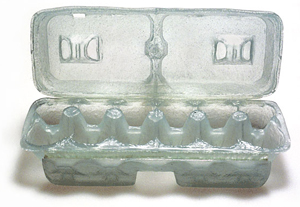 What do you consider your media? Do you consider it sculpture or specifically glass? “I call myself a sculptor who works mainly in cast glass. I also do printmaking, works on paper and mixed media on panels. I tend to approach non-sculptural media in a sculptural way. ”
What do you consider your media? Do you consider it sculpture or specifically glass? “I call myself a sculptor who works mainly in cast glass. I also do printmaking, works on paper and mixed media on panels. I tend to approach non-sculptural media in a sculptural way. ”
Talk to me about inspiration. I notice your earlier glass work, like the egg crates & ice trays, has a more whimsical feel while the current work has a more serene and ethereal feel. “My conceptual (earlier) work was inspired by a fascination with industrial design as well as ideas related to social commentary and observations of human behavior. Also, during that period, I had just started learning to cast glass and discovered that it’s very difficult. Problem solving is quite compelling to me so I was seeing how far I could push myself technically within the confines my philosophical framework.
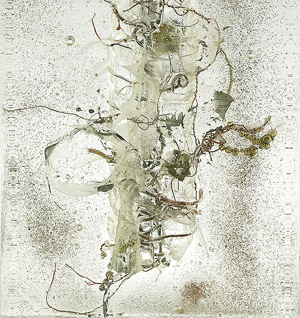 Sometimes I miss exploring the concepts behind my earlier style of work but for the most part I’m glad to have moved on. The older pieces are lost-wax kiln castings. The technique allows you to reproduce objects with a lot of precision but is very slow, boring, and labor intensive.
Sometimes I miss exploring the concepts behind my earlier style of work but for the most part I’m glad to have moved on. The older pieces are lost-wax kiln castings. The technique allows you to reproduce objects with a lot of precision but is very slow, boring, and labor intensive.
What inspires me most is the act of investigating: Researching images or techniques, discovering and learning a process, using unfamiliar materials or tools. Sometimes new ideas or ideas with potential to be brought to a higher level are an unexpected by-product of experimenting with materials.”
What style of art do you find unbearable to own? Anything “pretty” which is hard to define because that word means something different to everyone. On the other hand, an example comes to mind… certain Renoir paintings would be very difficult to live with.” Fascinating. I think many would would proffer the opinion that your work is “pretty,” although not necessarily in a Renoir sort of way. Again, fascinating.
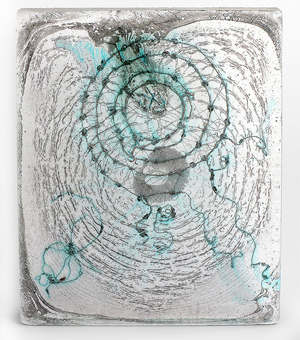 You know we have to talk about food. What is your favorite? “If I had the metabolism of a hummingbird my favorite would be comfort food– homemade macaroni and cheese, NY pizza, an old-fashioned doughnut or a vanilla malt milkshake. But… since I have the metabolism of a sloth, my favorite healthy compromise is eating a big salad for dinner.” Julie, you had me at mac-n-cheese, but I share your big-salad reality.
You know we have to talk about food. What is your favorite? “If I had the metabolism of a hummingbird my favorite would be comfort food– homemade macaroni and cheese, NY pizza, an old-fashioned doughnut or a vanilla malt milkshake. But… since I have the metabolism of a sloth, my favorite healthy compromise is eating a big salad for dinner.” Julie, you had me at mac-n-cheese, but I share your big-salad reality.
What about snack foods? “Sloth-Julie eats pretzels. Hummingbird Julie would eat barbecue potato chips or cookies.” I hope you don’t keep your hummingbird in a cage all the time. Eat a cookie.
So, what’s coming up next for you? “More experimenting with sand casting as well as another glass technique called fusing. Imbedding words or images and/or bubbles in my pieces and developing ideas for work about memory and cognition. Also, I enrolled in a Bullseye glass workshop (in Emeryville, CA) called “Image Transfers for Kiln Glass”. The class is taught by an artist I’ve admired for a long time, Carrie Iverson. It meets in January and will most likely spark exciting ideas for new work. I can’t wait!”
Thanks, Julie, for awakening both the mad scientist AND the zen yogi in us all…you are an inspiration for the coming new year.

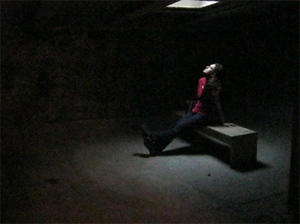

really enjoyed the interview, it helped bring the internet reproductions of the reproductions, come into a clearer view. Your attitude about aesthetics reminds me of why Rembrant painted sides of beef in a slaughterhouse. Interesting technique & art. i enjoyed meeting it.
I got to know Julie and her work working alongside her in a printmaking course in S.F.
I can tell you her prints are really beautiful and conceptual, and she brings the same level of
curiosity, chance, precision, and conceptual daring to her print work. One day she would make prints from carbon graphite on a plate composed with dried bubbling glue, and the next make a print using blue chalk rubbed on flattened geometric business envelopes. To be able to sustain that level of consistency with variation is the very mark of a mature and confident artist.